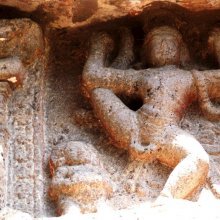Vrishcika, Vṛścika: 25 definitions
Introduction:
Vrishcika means something in Buddhism, Pali, Hinduism, Sanskrit, Marathi, Hindi, biology. If you want to know the exact meaning, history, etymology or English translation of this term then check out the descriptions on this page. Add your comment or reference to a book if you want to contribute to this summary article.
The Sanskrit term Vṛścika can be transliterated into English as Vrscika or Vrishcika, using the IAST transliteration scheme (?).
Alternative spellings of this word include Vrishchika.
Images (photo gallery)
(+9 more images available)
In Hinduism
Natyashastra (theatrics and dramaturgy)
Source: Wisdom Library: Nāṭya-śāstraVṛścika (वृश्चिक).—One of the 108 karaṇas (minor dance movement) mentioned in the Nāṭyaśāstra chapter 4. The instructions for this vṛścika-karaṇa is as follows, “the two hands bent and held over the shoulders, and a leg bent and turned towards the back.”.
A karaṇa represents a minor dance movements and combines sthāna (standing position), cārī (foot and leg movement) and nṛttahasta (hands in dancing position).

Natyashastra (नाट्यशास्त्र, nāṭyaśāstra) refers to both the ancient Indian tradition (shastra) of performing arts, (natya—theatrics, drama, dance, music), as well as the name of a Sanskrit work dealing with these subjects. It also teaches the rules for composing Dramatic plays (nataka), construction and performance of Theater, and Poetic works (kavya).
Vastushastra (architecture)
Source: Wisdom Library: Vāstu-śāstraVṛścika (वृश्चिक) corresponds with the Scorpio zodiac sign and refers to the eighth of twelve rāśi (zodiacal sign), according to the Mānasāra. Rāśi is one of the three alternative principles, besides the six āyādiṣaḍvarga, used to constitute the “horoscope” of an architectural or iconographic object. Their application is intended to “verify” the measurements of the architectural and iconographic object against the dictates of astrology that lay out the conditions of auspiciousness.
The particular rāśi (e.g., vṛścika) of all architectural and iconographic objects (settlement, building, image) must be calculated and ascertained. This process is based on the principle of the remainder. An arithmetical formula to be used in each case is stipulated, which engages one of the basic dimensions of the object (breadth, length, or perimeter/circumference). All twelve rāśis, except the eighth (vṛścika) are auspicious.

Vastushastra (वास्तुशास्त्र, vāstuśāstra) refers to the ancient Indian science (shastra) of architecture (vastu), dealing with topics such architecture, sculpture, town-building, fort building and various other constructions. Vastu also deals with the philosophy of the architectural relation with the cosmic universe.
Purana and Itihasa (epic history)
Source: valmikiramayan.net: Srimad Valmiki RamayanaVṛścika (वृश्चिक) refers to “scorpions” (in the forest), according to the Rāmāyaṇa chapter 2.28. Accordingly:—“[...] soothening with kind words to Sītā, when eyes were blemished with tears, the virtuous Rāma spoke again as follows, for the purpose of waking her turn back: ‘[...] Oh, frail princess! Flying insects, scorpions (vṛścika) insects including mosquitoes and flies always annoy every one. Hence, forest is full of hardship’”.

The Purana (पुराण, purāṇas) refers to Sanskrit literature preserving ancient India’s vast cultural history, including historical legends, religious ceremonies, various arts and sciences. The eighteen mahapuranas total over 400,000 shlokas (metrical couplets) and date to at least several centuries BCE.
Ayurveda (science of life)
Toxicology (Study and Treatment of poison)
Source: Shodhganga: Kasyapa Samhita—Text on Visha ChikitsaVṛścika (वृश्चिक) refers to “scorpions”, according to the Kāśyapa Saṃhitā: an ancient Sanskrit text from the Pāñcarātra tradition dealing with both Tantra and Viṣacikitsā—an important topic from Āyurveda which deals with the study of Toxicology (Viṣavidyā or Sarpavidyā).—In the beginning of the twelfth Adhyāya, Kāśyapasaṃhita adds external and internal antidotes for poisons of various animals and insects. The insect variety includes species [such as scorpion], and so on. [...]
The following treatments are mentioned for scorpions (vṛścika): “(1). A lepa or paste made from Māñjiṣṭhā, sandalwood, Doṣā flowers, Śirīṣa and lily combined with Śārṅga and Oṣṭha , remove the damage caused by scorpions. (2). Scorpion sting can be cured by tying a bandage of Mohinī or Spṛkkā on the place of the sting. (3). Placing salt and pepper in the mouth is also beneficial in decimating scorpion poison”.
Unclassified Ayurveda definitions
Source: Ancient Science of Life: Snake bite treatment in Prayoga samuccayamVṛścika (वृश्चिक) refers to “scorpion”, whose poison is dealt with in the 20th century Prayogasamuccaya (one of the most popular and widely practised book in toxicology in Malayalam).—Vṛścika-viṣa (scorpion envenomation) is the subject matter of chapter seven. The text recommends initial dhārā (pouring of a continuous and soothing stream of medicines) followed by pāna-yogas (drink recipes). If sting is severe, snake bite management steps should be undertaken. Immediate application of juice of Karañja (Pongamia pinnata) into eyes, mouth and bite site is said to relieve all types of scorpion poison according to the author.
Source: gurumukhi.ru: Ayurveda glossary of termsVṛścikā (वृश्चिका):—Scorpions.

Āyurveda (आयुर्वेद, ayurveda) is a branch of Indian science dealing with medicine, herbalism, taxology, anatomy, surgery, alchemy and related topics. Traditional practice of Āyurveda in ancient India dates back to at least the first millenium BC. Literature is commonly written in Sanskrit using various poetic metres.
Vaishnavism (Vaishava dharma)
Source: Pure Bhakti: Arcana-dipika - 3rd EditionVṛścika (वृश्चिक) corresponds to “scorpio” (mid November to mid December) and refers to one of the zodiac signs (rāśī) in the Vedic calendar.—Rāśī refers to the different signs of the zodiac through which the sun travels. For precise dates, please refer to a Vedic calendar. In accordance with the zodiac sign the sun is situated in, one would utter [for example, vṛścika-rāśī sthite bhāskare]

Vaishnava (वैष्णव, vaiṣṇava) or vaishnavism (vaiṣṇavism) represents a tradition of Hinduism worshipping Vishnu as the supreme Lord. Similar to the Shaktism and Shaivism traditions, Vaishnavism also developed as an individual movement, famous for its exposition of the dashavatara (‘ten avatars of Vishnu’).
Jyotisha (astronomy and astrology)
Source: Wisdom Library: Brihat Samhita by VarahamihiraVṛścika (वृश्चिक) or Alin refers to the sign of Scorpio, according to the Bṛhatsaṃhitā (chapter 5), an encyclopedic Sanskrit work written by Varāhamihira mainly focusing on the science of ancient Indian astronomy astronomy (Jyotiṣa).—Accordingly, “If the sun and moon should begin to be eclipsed when only half risen, deceitful men will suffer as well as sacrificial rites. [...] If they should be eclipsed when in the sign of Libra (Tulā), the people of the extreme border lands on the west, the people of Sindha, the trading classes and the people of Kaccha will be afflicted with miseries. If when in the sign of Scorpio (Vṛścika) [i.e., alin], the people of Udambara, of Madra, of Colā and of Yaudheya will all suffer miseries along with soldiers armed with poisoned weapons”.

Jyotisha (ज्योतिष, jyotiṣa or jyotish) refers to ‘astronomy’ or “Vedic astrology” and represents the fifth of the six Vedangas (additional sciences to be studied along with the Vedas). Jyotisha concerns itself with the study and prediction of the movements of celestial bodies, in order to calculate the auspicious time for rituals and ceremonies.
Shaivism (Shaiva philosophy)
Source: Google Books: Manthanabhairavatantram (shaivism)Vṛścika (वृश्चिक) refers to a “scorpion”, according to the Śrīmatottara-tantra, an expansion of the Kubjikāmatatantra: the earliest popular and most authoritative Tantra of the Kubjikā cult. Accordingly, “O goddess, Svacchanda is in the middle, within the abode of the triangle. Very powerful, he has five faces with three times five flaming eyes. [...] O fair lady, my attributes—trident, dagger, sword, the king of the snakes, and rosary—adorn the right (arms). O beloved, a skull, double-headed drum, javelin, noose and goad—(these) are my divine, brilliant and very auspicious weapons that (are held) in the left (hands). The king of snakes (hangs) on the shoulder and a garland of skulls hangs (from the neck). There is a necklace of scorpions [i.e., vṛścika-hāra] around the throat and the ears are adorned with snakes. [...]”.

Shaiva (शैव, śaiva) or Shaivism (śaivism) represents a tradition of Hinduism worshiping Shiva as the supreme being. Closely related to Shaktism, Shaiva literature includes a range of scriptures, including Tantras, while the root of this tradition may be traced back to the ancient Vedas.
Shaktism (Shakta philosophy)
Source: Google Books: ManthanabhairavatantramVṛścika (वृश्चिक) refers to “scorpions”, according to the Kularatnoddyota, one of the earliest Kubjikā Tantras.—Accordingly, “That, O goddess, is said to be the subtle (form), now listen to the gross one. [...] She holds a skull, dagger, javelin and ascetic’s staff. Fierce, she holds a knife, a great noose and sword. (She also holds) a thunderbolt, spear, bow, arrows and double-headed drum. Her neck is adorned with the great lord of snakes. She wears a snake as a sacred thread and (her) girdle is tied with that also. She is adorned with the thousand-headed lord of the snakes (who is) on (her) head. Snakes are (her) anklets and bangles. Her topknot has the form of a burning fire and scorpions are (her) rings [vṛścika—vṛścikairaṅgulīyakam]”.

Shakta (शाक्त, śākta) or Shaktism (śāktism) represents a tradition of Hinduism where the Goddess (Devi) is revered and worshipped. Shakta literature includes a range of scriptures, including various Agamas and Tantras, although its roots may be traced back to the Vedas.
General definition (in Hinduism)
Source: archive.org: Vedic index of Names and SubjectsVṛścika (वृश्चिक) in the Rigveda and the Atharvaveda denote ‘scorpion’. Its poison was feared like that of serpents. It is described as lying torpid in the earth during winter.
In Buddhism
Mahayana (major branch of Buddhism)
Source: Wisdom Library: Maha Prajnaparamita SastraVṛṣcika (वृष्चिक, “scorpion”) represents an incarnation destination of the tiryaggati (animal realm) according to the “world of transmigration” section in the 2nd century Mahāprajñāpāramitāśāstra (chapter XXVII).—The Bodhisattva sees the animals (tiryak) undergoing all the torments: they are made to gallop by blows of the whip or stick; they are made to make long journeys carrying burdens; their harness is damaged; they are branded with hot iron. If hatred (dveṣa, pratigha) is predominant [in people], they take the form of [for example] scorpion (vṛṣcika).

Mahayana (महायान, mahāyāna) is a major branch of Buddhism focusing on the path of a Bodhisattva (spiritual aspirants/ enlightened beings). Extant literature is vast and primarely composed in the Sanskrit language. There are many sūtras of which some of the earliest are the various Prajñāpāramitā sūtras.
Tibetan Buddhism (Vajrayana or tantric Buddhism)
Source: Wisdom Library: Tibetan BuddhismVṛścika (वृश्चिक) is the name of a Rāśi (zodiac sign) mentioned as attending the teachings in the 6th century Mañjuśrīmūlakalpa: one of the largest Kriyā Tantras devoted to Mañjuśrī (the Bodhisattva of wisdom) representing an encyclopedia of knowledge primarily concerned with ritualistic elements in Buddhism. The teachings in this text originate from Mañjuśrī and were taught to and by Buddha Śākyamuni in the presence of a large audience (including Vṛścika).

Tibetan Buddhism includes schools such as Nyingma, Kadampa, Kagyu and Gelug. Their primary canon of literature is divided in two broad categories: The Kangyur, which consists of Buddha’s words, and the Tengyur, which includes commentaries from various sources. Esotericism and tantra techniques (vajrayāna) are collected indepently.
Biology (plants and animals)
Source: Google Books: CRC World Dictionary (Regional names)Vrscika in India is the name of a plant defined with Girardinia diversifolia in various botanical sources. This page contains potential references in Ayurveda, modern medicine, and other folk traditions or local practices It has the synonym Girardinia adoensis (Steud.) Wedd. (among others).
Example references for further research on medicinal uses or toxicity (see latin names for full list):
· Fl. China. (2003)
· Acta Phytotaxonomica Sinica (1992)
· Voyage dans l’Inde (1844)
· Annales des Sciences Naturelles; Botanique (1854)
· Journal of Japanese Botany (1998)
· Contributions to Nepalese Studies (2003)
If you are looking for specific details regarding Vrscika, for example pregnancy safety, diet and recipes, health benefits, chemical composition, side effects, extract dosage, have a look at these references.

This sections includes definitions from the five kingdoms of living things: Animals, Plants, Fungi, Protists and Monera. It will include both the official binomial nomenclature (scientific names usually in Latin) as well as regional spellings and variants.
Languages of India and abroad
Marathi-English dictionary
Source: DDSA: The Molesworth Marathi and English Dictionaryvṛścika (वृश्चिक).—m S A scorpion. 2 A sign of the zodiac, Scorpio.
Marathi is an Indo-European language having over 70 million native speakers people in (predominantly) Maharashtra India. Marathi, like many other Indo-Aryan languages, evolved from early forms of Prakrit, which itself is a subset of Sanskrit, one of the most ancient languages of the world.
Sanskrit dictionary
Source: DDSA: The practical Sanskrit-English dictionaryVṛścika (वृश्चिक).—[vraśc-kikan]
1) A scorpion.
2) The sign Scorpio of the zodiac.
3) A crab.
4) A centipede.
5) A kind of beetle.
6) A hairy caterpillar.
7) The month when the sun is in Scorpio.
-kā, -kī An ornament for the toes.
Derivable forms: vṛścikaḥ (वृश्चिकः).
Source: Cologne Digital Sanskrit Dictionaries: Shabda-Sagara Sanskrit-English DictionaryVṛścika (वृश्चिक).—m.
(-kaḥ) 1. A scorpion. 2. The sign Scorpio of the zodiac. 3. A hairy caterpillar. 4. A crab. 5. A sort of beetle found in cowdung. 6. A centipede. 7. A thorny shrub, (Vangueria spinosa.) 8. The month when the sun is in Scorpio. f.
(-kā) A potherb. (Basella.) E. vraśc to cut, Unadi aff. kikan, and the semi-vowel changed to the vowel.
Source: Cologne Digital Sanskrit Dictionaries: Benfey Sanskrit-English DictionaryVṛścika (वृश्चिक).— (vb. vraśc), m. 1. A scorpion, [Bhāgavata-Purāṇa, (ed. Burnouf.)] 3, 30, 27. 2. The sign Scerpio. 3. A caterpillar. 4. A crab. 5. A centipede. 6. A sort of beetle.
Source: Cologne Digital Sanskrit Dictionaries: Cappeller Sanskrit-English DictionaryVṛścika (वृश्चिक).—[masculine] scorpion.
Source: Cologne Digital Sanskrit Dictionaries: Monier-Williams Sanskrit-English Dictionary1) Vṛścika (वृश्चिक):—[from vṛścana] a m. a scorpion, etc. etc.
2) [v.s. ...] the zodiacal sign Scorpio, [Varāha-mihira’s Bṛhat-saṃhitā; Purāṇa]
3) [v.s. ...] the month when the sun is in Scorpio, [Horace H. Wilson]
4) [v.s. ...] a kind of caterpillar covered with bristles, [cf. Lexicographers, esp. such as amarasiṃha, halāyudha, hemacandra, etc.]
5) [v.s. ...] a sort of beetle found in cow-dung, [Horace H. Wilson]
6) [v.s. ...] a centipede, [ib.]
7) [v.s. ...] Name of various plants (Boerhavia Procumbens = madana etc.), [cf. Lexicographers, esp. such as amarasiṃha, halāyudha, hemacandra, etc.]
8) Vṛścikā (वृश्चिका):—[from vṛścika > vṛścana] f. Boerhavia Procumbens, [cf. Lexicographers, esp. such as amarasiṃha, halāyudha, hemacandra, etc.]
9) [from vṛścika > vṛścana] f. an ornament for the toes, [Demetrius Galanos’s Lexiko: sanskritikes, anglikes, hellenikes]
10) Vṛścīka (वृश्चीक):—[from vṛścana] m. a species of plant, [Suśruta]
11) Vṛścika (वृश्चिक):—[from vraśc] b etc. See p. 1011, col. 3.
Source: Cologne Digital Sanskrit Dictionaries: Yates Sanskrit-English DictionaryVṛścika (वृश्चिक):—(kaḥ) 1. m. A scorpion, sign scorpio; a centipede; a crab; sort of beetle; thorny shrub. f. A potherb.
Source: DDSA: Paia-sadda-mahannavo; a comprehensive Prakrit Hindi dictionary (S)Vṛścika (वृश्चिक) in the Sanskrit language is related to the Prakrit word: Viṃcua.
[Sanskrit to German]
Sanskrit, also spelled संस्कृतम् (saṃskṛtam), is an ancient language of India commonly seen as the grandmother of the Indo-European language family (even English!). Closely allied with Prakrit and Pali, Sanskrit is more exhaustive in both grammar and terms and has the most extensive collection of literature in the world, greatly surpassing its sister-languages Greek and Latin.
Hindi dictionary
Source: DDSA: A practical Hindi-English dictionaryVṛścika (वृश्चिक) [Also spelled vraschik]:—(nm) a scorpion; —[rāśī] Scorpio —the eighth sign of zodiac.
...
Kannada-English dictionary
Source: Alar: Kannada-English corpusVṛścika (ವೃಶ್ಚಿಕ):—
1) [noun] any of numerous arachnids of the order Scorpionida, widely distributed in warmer parts of the world, having a long, narrow, segmented tail that terminates in a venomous sting; a scorpion.
2) [noun] any of various decapods with four pairs of legs, one pair of pincers, a flattish shell, and a short, broad abdomen folded under its thorax; a crab.
3) [noun] any of a class (Chilopoda) of elongated, many-segmented, insect-eating arthropods with a pair of legs to each segment; a centipede.
4) [noun] the wormlike larva of various insects, esp. of a butterfly or moth; a caterpillar.
5) [noun] any of various families of winged hymenopteran insects, characterised by a slender body with the abdomen attached by a narrow stalk, biting mouthparts, and, in the females and workers, a vicious sting that can be used repeatedly; a wasp.
6) [noun] the plant Girardinia zeylanica ( = G. heterophylla) of Urticaceae family; itching plant.
7) [noun] (fig.) a wicked fellow.
8) [noun] (astrol.) the eighth sign of the zodiac; the Scorpio.
9) [noun] the eighth month in the solar calendar, starting from the day the sun enters the Scorpio.
Kannada is a Dravidian language (as opposed to the Indo-European language family) mainly spoken in the southwestern region of India.
See also (Relevant definitions)
Starts with (+1): Vrishcikacchada, Vrishcikahara, Vrishcikakshvela, Vrishcikakuttita, Vrishcikali, Vrishcikamantra, Vrishcikamasa, Vrishcikanasha, Vrishcikanashamantra, Vrishcikanguliyaka, Vrishcikapaha, Vrishcikapasrita, Vrishcikapatri, Vrishcikapattrika, Vrishcikapriya, Vrishcikarashi, Vrishcikarecita, Vrishcikarni, Vrishcikasana, Vrishcikavisha.
Ends with: Jalavrishcika, Latavrishcika, Patravrishcika, Pattravrishcika, Shvetavrishcika, Vyamsitavrishcika.
Full-text (+71): Jalavrishcika, Nakhaparni, Vrishcikapriya, Vrishcikali, Vrishcikarashi, Vrishcikesha, Vrishcikamasa, Vrishcana, Vrishcikapattrika, Vrishcikacchada, Vrishcikapatri, Avanisutakshetra, Rashi, Vrishci, Vrishciki, Vimcua, Pattravrishcika, Sarpavrishcikaromavat, Vrishcikarni, Vrishcipattri.
Relevant text
Search found 20 books and stories containing Vrishcika, Vṛścika, Vrscika, Vṛścikā, Vṛścīka; (plurals include: Vrishcikas, Vṛścikas, Vrscikas, Vṛścikās, Vṛścīkas). You can also click to the full overview containing English textual excerpts. Below are direct links for the most relevant articles:
Gati in Theory and Practice (by Dr. Sujatha Mohan)
Gati in aerial sphere < [Chapter 3 - Application of gati in Dṛśya-kāvyas]
Elucidation of Karaṇas related to Gati < [Chapter 2 - Concept and technique of Gati]
Gati in Maṇipurī < [Chapter 4 - Practice of Gati]
Puranic encyclopaedia (by Vettam Mani)
Rig Veda (translation and commentary) (by H. H. Wilson)
Rig Veda 1.191.16 < [Sukta 191]
The Religion and Philosophy of Tevaram (Thevaram) (by M. A. Dorai Rangaswamy)
Chapter 4.3 - (c) Sculptures of Shiva and Dance < [Volume 2 - Nampi Arurar and Mythology]
Chapter 2.1 - Vishapaharana-murti (depiction of swallowing the poison) < [Volume 2 - Nampi Arurar and Mythology]
Cosmetics, Costumes and Ornaments in Ancient India (by Remadevi. O.)
2.5. Pharmaceutical use of Nail Polish < [Chapter 1 - Cosmetics]
The Indian Buddhist Iconography (by Benoytosh Bhattachacharyya)





